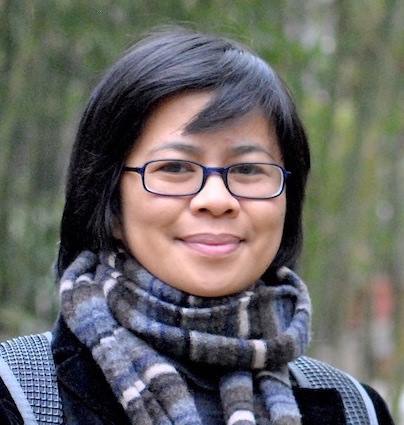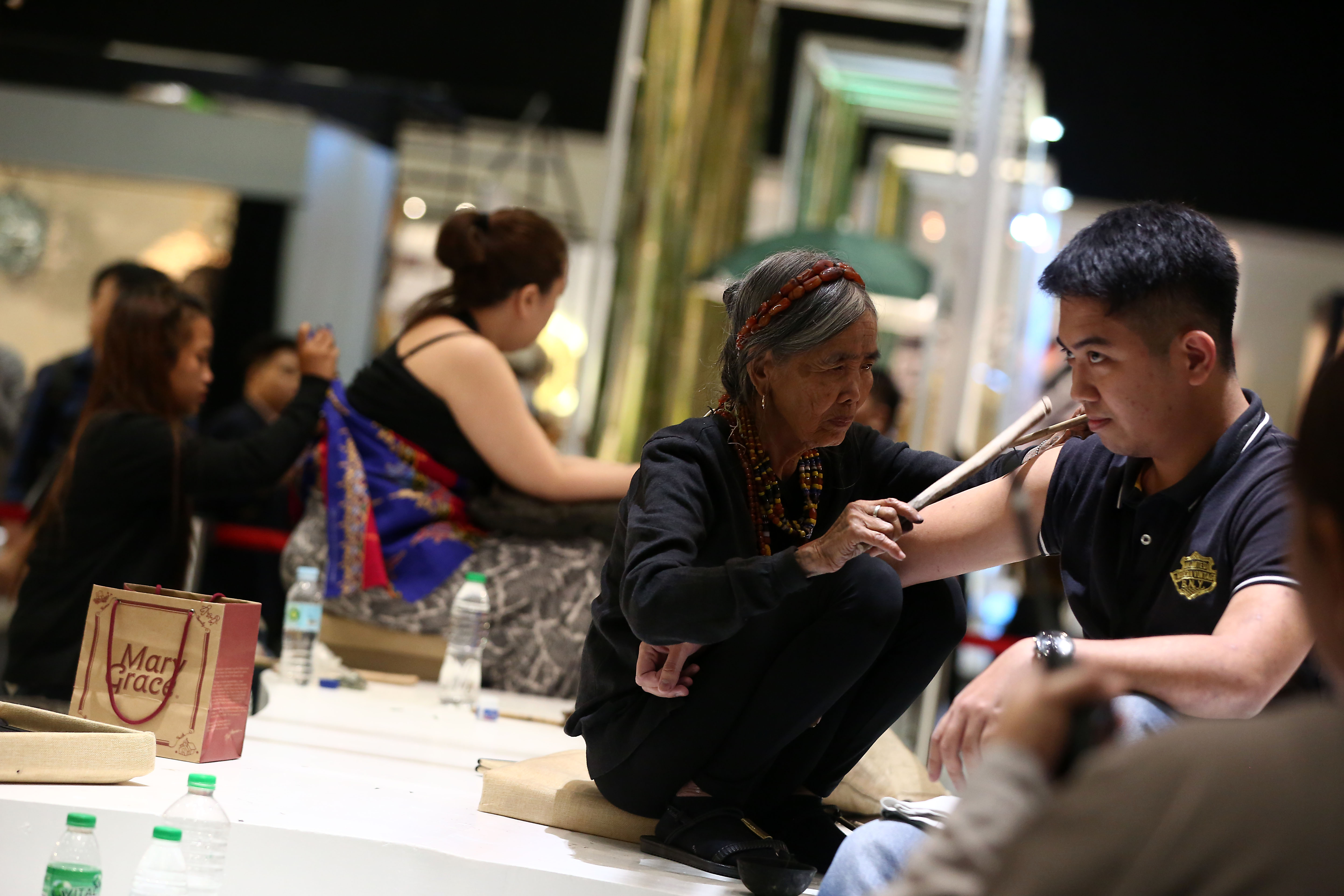
I was in Aparri, Cagayan when Apo Whang-od was brought to the Manila FAME to "perform" a tattoo demontration, speak in a panel, and to attend the announcement of her nomination to the GAMABA (Gawad ng Manlilikha ng Bayan or the National Living Treasure Award), which reportedly was accepted by the National Commission for Culture and the Arts (NCCA) last October 21.
I was also invited by the organizers to be in a panel, but declined. When I returned, I was bombarded with articles that she was “exploited” reminiscent of the 1904 St Louis Exposition, and on the other, that she “fully enjoyed” her stay in Manila and back in Buscalan.
Examining both sides of the story, I was also alarmed that I received messages on why I am I not doing anything despite the many accolades I received from conducting research on Kalinga tattoos (that is certainly unwarranted), but nevertheless, I am confounded. Here are some thoughts.
Was she exploited?
Did we ever ask Apo Whang-od directly or personally if she was indeed “exploited”? What did she think of the event? I have asked Apo Whang-od many times in my previous research and many visits to the village, if she likes what she is doing, most especially with the influx of tourists coming in to get tattoos.
I usually get a reply that “she loves what she is doing, and she will tattoo as much as she can, as long as her eyes can see.” She is also a good-natured person (to the point of being misled), and she would accommodate this in full-energy like what a Butbut-Kalinga woman would do.
With the unfolding of events before our eyes, who are we to deny these things to her: the opportunity to travel and to see other places (like Manila), to earn more (reportedly a take home of P800,000 for her appearance and demos), and to meet people (like Coco Martin) and to ride on with each other’s popularity.
Apo Whang-od is also a human being, already a cultural icon. Some would see her as a goddess on a pedestal, but like any other person, she also has her own agency. It is “us” (our outsider’s view, our “othering,” our etic perspective) that gives this ideological interpretation that it was unfair, unjust, and exploitative in nature, but did we ask her?

To the organizers of the event, it is a most admirable act to bring in the centenarian Apo Whang-od on board with all the resources and logistics all set, but I hope that you planned and curated the show well. With the tattoo practitioners on cordon, you made them look like “public performers for a fee” (“tattoo for a fee”) which could have been more interactive, and not exclusive.
We could honor Apo Whang-od and her craft in a most respectable way and for a rare occasion such as this, a fitting tribute should be perfectly fine, moreso, to listen to Apo Whang-od’s voice, her thoughts and her stories with the proper translation from her Butbut language to Filipino or English (most of the attendees have an English twang).
But having to tattoo from 8 am to 4 pm for the event and have a "piece" of her is way too much, there should be a limit for this tattoo demonstrations. How is this setting different when she tattoos in Buscalan with more than hundreds of visits per day and the many people in queue to get inked by her?
She has proven herself well, with the beautiful human canvass she produced for years when she started tattooing in her home village up to now. Of course, Apo Whang-od as I know her, would insist to tattoo, because this is what is expected of her. She would tell me that she is always “naontog” (strong), but her age and health is an issue that we should be conscious of the need to conserve and preserve her energy.
She also talks of "chayaw" (or praise and honor for the Kalinga) and to live by these expectations. Miscommunication or blocking of communication is also rife in the event, between Apo Whang-od to the organizers, and to the people that flocked to her to get tattoos. Did we talk to her? And how does she feel? She left Manila with all smiles and waved heartily as she boarded the helicopter back to Buscalan, how does she really feel? For all I know, she would say "I did it!" to cap the "high" expectations from her.

Pollution of culture?
We should not be a “romantic anthropologist” when we view culture as something that is “pure,” “traditional” or “pristine.” Kalinga tattoos also evolve, never static and always dynamic. It also goes with the flow of modernity. Like the people, the tattoos also go through the process of inevitable change.
But what I implore is to have this sensibility and sensitivity to culture, and to respect the practitioners of the tradition, whether Apo Whang-od is in Buscalan or elsewhere. Respect is of utmost importance here. Why do people get tattoos from Whang-od? Because people buy the story behind the tattoos: the rarity of designs, the technique and the stature of Whang-od as the “last, oldest tattoo artist” ascribed by popular media.
With the popularity of tattoos nowadays, and with the (sh)/fame in the Manila event, we could observe that we could talk now of appearing cultures instead, rather than disappearing cultures, and the tattooing culture is revived.
The events also help us erase the pejorative notion of tattoos whether that is traditional or not. Today, we have the younger generation of tattoo practitioners: Grace Palicas, Elyang Wigan (and others, plus recently the youngest 12-year-old tattoo artist), and Den Wigan – who have seriously taken on their hands the handtapping tattoo. Is this not worth celebrating for as well as we are assured of the continuity of a tattoo tradition?
The context of traditional tattoos was different in the past when these tattoos were place-based rituals and a collective practice for the Kalinga. The motivations for getting tattoos now have become more personal, to make permanent the individual experiences of the people whether you are diasporic Filipinos, urban or foreign tourists coming in to get inked from the village, or in the Manila FAME event.
Nomination of Apo Whang-od to the GAMABA
For those strongly advocating for the nomination of Apo Whang-od to become a National Living Treasure (Take note: this is different from the National Artist Awards), I have no objections. But let us peruse the guidelines carefully and understand it well.
For anyone nominated to the Gawad sa Manlilikha ng Bayan Awards or GAMABA, the cultural practitioner should continue to practice her craft and not to earn profit from it.
Apo Whang-od is in a precarious situation because although she continues to tap the traditional way, she earns by tattooing tourists. Unless the NCCA praise committee makes an exemption, we still have to await for their decision. Whatever the results are, we also need to respect the decision.
With the many events unfolding in our eyes, what we see now is a greater appreciation of the young to traditional tattoos (which is good, but also have a downside in Buscalan, this is for another discussion).
With Whang-od’s tattoos now a popular brand, it is so addictive that you can’t stop and must die hard to have it. For me, I am content with the sight of her, and to hear her tapping, and not aggressively want to be inked by her. I also respect the many people who refused to get tattoos and be part of commodification of culture. Kudos!
We can celebrate Apo Whang-od and her craft in a most honorable and respectable way, but not in a circus such as what we all have witnessed. But for Apo Whang-od, it could be one of her memorable experiences as long as she lives, and surely it will be retold. Manjamanak!
Analyn Salvador-Amores, an alumna of the University of the Philipines Diliman and Oxford University, authored the award-winning book "Tapping Ink, Tattooing Identities: Tradition and Modernity in Contemporary Kalinga Society" (UP Press, 2013). She is an associate professor of social anthropology at UP Baguio and the director of the Museo Kordilyera, the university's Ethnographic Museum.